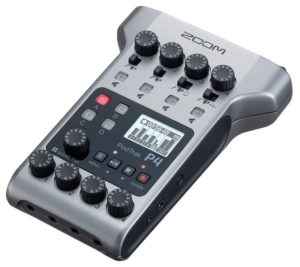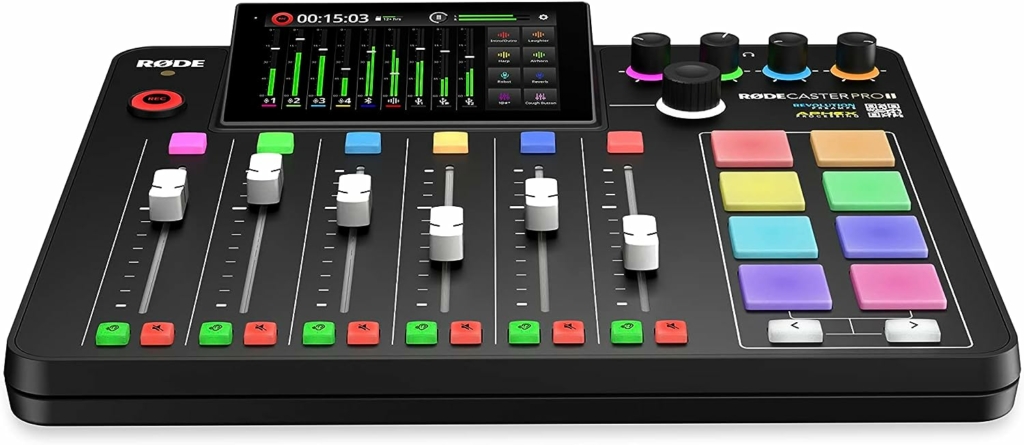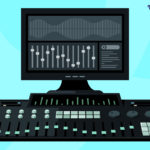Best Podcast Mixers: Costs, Features, & Flexibility (Our Top Picks)
Best Podcast Mixers: At-a-Glance
- You don’t need a mixer to podcast, but there are reasons to want one!
- One of them is increased control and flexibility in recording (be it locally or remotely).
- A mixer can help you cut down on your editing time, too.
- However, they can add an extra layer of complexity to your setup.
- So, should you get a mixer for your podcast? And if so, which ones are your best options?
- Read on to find out 👇
We often joke here that podcast mixers appear more in stock photos than they do in actual podcast setups. They definitely look cool – l33t podcasting ahoy! – but are they really useful? Well, that’s a good question, because – unlike a microphone – you definitely don’t need a mixer to podcast.
If you’d like to dig into the reasons why you might (or might not) want one, then hop on down to this section. Otherwise, let’s kick on with some of the best podcast mixer recommendations.
A quick heads up: We use affiliate links on the site to help support the masses of free content we put out. We’ll earn a small commission should you choose to buy through any of them – at no extra cost to yourself.
Best Budget Mixer for Podcasting
I’m going to offer a range of podcast mixers based on price. I won’t venture into the “extreme budget” range because, honestly, they’re just not very good. If you’re strapped for cash, then avoid mixers altogether. That said, you can get some pretty good gear for surprisingly little, if you know what to look for – which you will at the end of this roundup. And that takes us nicely to our mid-range recommendations…
Best Mid-Range Mixer for Podcasting
Zoom Podtrak P4 ($150)

- XLR Inputs: 4
- Channels: 4
- Buy the Zoom Podtrak P4
Weirdly, my current favourite mixer isn’t technically a mixer… Thing is, it can do practically everything a mixer can do, but in a much more flexible package!
The PodTrak P4 is technically a handheld podcast recorder. Despite that, it really does replace a mixer, doing the same things in a more straightforward and accessible way.
The device can take four XLR mics as inputs, so you can cater to a decent-sized group, and there’s individual volume control over every channel. Even better, there are headphone outputs for all four, with individual volume control on each. This is more than you get on most pro mixers!
The Podtrak can also take input from your phone or PC, so you can record calls right into the device. Add in a set of programmable sound pads on the front (just punch the button and it’ll play music or FX right into the recording), and it’s a tiny device that can do live production for a group of in-person presenters, plus remote guests.
Of course, that’s just the mixer-like features. Don’t forget this thing is handheld, so you can get out and about for recording anywhere. Plus, it can act as a USB device on your PC, to plug in any pro XLR microphone for general recording.
Safe to say, I like this little gadget, and you can see how much Matthew loves it in his full review of the Zoom PodTrak P4.
The fact that it’s only $150 / £155 is a little crazy. To me, it strongly competes with the Rodecaster (below) on features, but is a fraction of the price. If you think you might record with more than one person, locally, and you fancy some live production through the soundpads and remote call-ins, then this is a really great choice.
MackieMix8 ($98)
Mackie are a famous audio equipment company renowned for their quality. This compact mixer is also available as the Mix5 (1 XLR, 5 channels) or the Mix12 (4 XLRs, 12 channels). Mackie also offers the podcaster-focused DLZ creator unit, which we’ll read about shortly, but it will be out of the price range of most podcasters.
- XLR Inputs: 2
- Channels: 8
- Buy the MackieMix8
Maono Maonocaster ($120)
The Maonocaster is the other podcaster-focused interface in this category. In our Maonocaster review, Sarah commented that “the functionality seems to sway more towards live audio such as streaming.” and felt that the sound quality was short of what more established podcasters might be looking for. If you’re looking for a podcaster-first device in this price range, see if you can stretch to a Zoom PodTrak P4 instead.
- XLR Inputs: 1
- Channels: 10
- Buy the Maonocaster
Roland GO:MIXER PRO-X ($120)
This is a palm-sized audio mixer for mobile devices. It’s marketed towards folks who make music videos, web shows, podcasts, or livestreams with a phone or tablet. THE NAME IS ALSO IN FULL CAPS. Flex move!
- XLR Inputs: 1
- Channels: 4
- Buy the Go:MIXER PRO-X
Behringer Xenyx 1204 ($190)
Falling very much into the “traditional” mixer aesthetic of functionality over sleekness, this is still a highly recommended and very popular podcast mixer. A lot of Behringer’s more budget kit has questionable sound, but this one holds its own in its category. It has USB capabilities, too, which isn’t so common in more traditional musician-focused mixers.
- XLR Inputs: 4
- Channels: 8
- Buy the Xenyx 1204
The Yamaha MG10XU ($265)
This classic Yamaha mixer was a constant presence in our studio for a few years, up until we replaced it with the Rodecaster (below). The MG10XU is the USB model, the MG10X has built-in effects, and the MG10 is the standard analogue version.
- XLR Inputs: 4
- Channels: 10
- Buy the Yamaha MG10XU
Best Pro-Level Podcast Mixer

Rode Rodecaster Pro II ($700)
- XLR Inputs: 4
- Channels: 9
- Buy the Rodecaster Pro II here
The best player in this category is the Rodecaster II from…. well… Rode! The original Rodecaster was the first of its kind – an all-in-one studio mixer built just for podcasters. You’ll see from this roundup that there are many more of these interfaces on the market nowadays, but the Rodecaster has the advantage of being the trailblazer in its field.
This podcast mixer has a slew of features aimed right at the podcasting market. We go into them in-depth in our dedicated Rode Rodecaster II review, but here are some highlights:
- Take the sound cart buttons, designed for you to play music and Sound FX into your show WITHOUT the need for an external device.
- Ditch that iPad and load them into the unit itself. Then, marvel over the smartphone Bluetooth connection, so that you can record calls (or anything else really!) right into your show too, no cables required.
- It even acts as a digital recorder, coming with memory card capture built right in. So, if you regularly get out, recording shows on the road, then that’s one less piece of kit to take with you.
The Rodecaster Pro II is not cheap, and it’s not for everyone. But it could be perfect for some. The Zoom Podtrak has many of the same capabilities, is much better value and a lot more portable. But, the Rodecaster Pro II is undoubtedly a bigger and better device. If the price puts you off, though, then check out the Tascam Mixcast 4 and Rodecaster Duo, mentioned below.
Tascam Mixcast 4 ($370)
Tascam gets mentioned a lot less than Zoom in the portable digital recorder world, but their gear is every bit as good. The Mixcast 4 is the company’s venture into the “dedicated podcast studio” market. A great option for folks eyeing up the Rodecaster or Mackie DLZ but looking to fork out a lot less cash.
- XLR Inputs: 4
- Channels: 14
- Buy the Tascam Mixcast 4
Boss Gigcaster 5 ($465)
Our reviewer Dev loved the Boss Gigcaster 5 so much that they bought their review unit from Boss. But, although it has “caster” in its name, it’s not so podcast-focused as some of the other mixers mentioned here. A great option for podcasters who also dabble in music or live performance, and available as the bigger Boss Gigcaster 8 model, too. Read more about both in our Boss Gigcaster 5 & 8 review.
- XLR Inputs: 2
- Channels: 5
- Buy the Boss Gigcaster 5
Rode Rodecaster Duo ($500)
Rode’s flagship podcast recorder may be the Rodecaster II, but even they acknowledge that few podcasters need four mic inputs. With that in mind, the Rodecaster Duo gives you almost everything the Rodecaster II does, but with half the mics. No, this doesn’t half the price, but it knocks a couple of hundred off it, at least. Read our Rodecaster Duo review for the full lowdown.
- XLR Inputs: 2
- Channels: 7
- Buy the Rode Rodecaster Duo
Mackie DLZ ($820)
We came across Mackie’s Mix range earlier on, and now we come to their “we can be the most expensive podcast mixer on the market” option. Undoubtedly a fantastic device, but it outprices even the Rodecaster II, and you can pick up the Tascam Mixcast 4 for less than half the amount. Maybe one to keep an eye on for any future deals or discounts.
- XLR Inputs: 4
- Channels: 12
- Buy the Mackie DLZ
Do I Need a Mixer for Podcasting?
Now that we’ve had a look at the best mixers for podcasting, do you need to run out and spend your hard-earned cash on one? The answer is no.
I’ll start by saying that, yes, a mixer will improve your audio quality. The pre-amps will be nicer and will really help your microphone shine. But, if you have a decent microphone already, then it’s not going to make as much of a difference. At that level, it’s certainly not something that’ll suddenly win you a load more listeners.
Audio Engineers buy mixers for the sheer audio quality, but podcasters buy mixers for the options and the control that they offer, as well as the efficiency they can bring to our recording workflow.
Our 2019 podcast gear survey showed that around half of podcasters used some mixer or audio interface. Many others will still be creating great-sounding audio using a high-end USB mic and a double-ender recording app, though. In podcasting, there’s never one single right way to do things.
Main Reasons to Buy a Podcast Mixer
So let’s have a look at the details – here are the reasons why a Podcaster might buy a mixer:
1. Using Other Pro Kit
If you want to use professional quality microphones that work with XLR or other pro-type cabling, then to get the best out of them, you’re going to need a mixer or audio interface.
It is possible to get XLR > USB converters, but they won’t take as much advantage of the quality of your mic.
2. Multi-Channel Control
Having control over the individual channels of your audio is one of the simplest but biggest enhancements that a mixer brings into your life. In your early days, you’ll be recording everyone on one channel. That means loud people are loud, and quiet people are quiet. With a podcast mixer, you can actually turn up those quiet folks and turn down the shouters. Plus, you can record them on different channels and have much more power in post-production. Excellent!
3. Inline Enhancements
Inline enhancements work hand-in-hand with the multi-channel capability and are great for improving your sound. They can also save you a whole lot of time in post-production. The ability to use a low-cut or high-cut filter, equalisation, and gain on each channel individually is brilliant. Plus, some podcast mixers have compression and limiters, too.
4. Backup and reliability
Unlike computers, podcast mixers don’t crash, and I’ve never seen a digital recorder do so, either. You can cut out the computer component altogether, reducing noise and flakiness, or you can record using software and with the mixer as a backup recording, sending a second output to the digital recorder.
5. Live Production
Live producing means adding your music, your sound FX, phone calls, recorded messages, and anything else that goes into your show on the fly – it’s all going in live. You’re treating it like a radio show, so there’s no post-production at all. You simply hit record, do the show, and then stop.
Afterwards, you might apply some compression or EQ in Post, but all the audio you need is already in there. Editing is cut down dramatically.
6. Mix-Minus
In the era of sophisticated double-ender recording software, this is a lot less important than it once was. But it’s still worth mentioning.
The mix-minus approach was common during the era when Skype was the planet’s foremost podcast recording platform. It’s a setup that helps prevent hosts from hearing their own voice being played back to them through the mixer, but, they can still hear their music, sound effects, and guest.
You can do this with any mixer that has an ‘Auxiliary Out’ or an ‘FX send’ on it, and a fader or a knob to control that output. In practice, you plug that Aux/FX into Skype or any other call software, and then you turn down the Aux/FX knob on the Skype channel alone. That means you can’t hear yourself on that channel, but can hear everything else.

Here’s our guide to setting up a mix-minus for your podcast recording. But, it’s unlikely you’ll need to worry about it nowadays. As I say, most remote recording platforms take care of it all for you automatically.
What to Look for When Buying a Podcast Mixer
If you’ve decided to buy a podcast mixer, here comes the tricky part. The range of mixers on the market is bewildering, and the choice isn’t made any easier by the ridiculous number of features and specs listed for each one.
The problem is that many mixers are designed for Audio Engineers, and those guys know a LOT about the technical details. Therefore, those that sell mixers plaster the tech specs all over the website.
But, as a podcaster, there are three things you need to worry about:
1. Number of Inputs & Channels
My own setup uses four channels on a regular basis. This is made up of:
- My own microphone
- A local co-hosts microphone
- Music and FX via iPad
- Software input for remote calls
I’ll sometimes have a mobile phone plugged into another channel and another local co-host, so I need a minimum of six channels and probably three XLR inputs to be safe.
Many cheaper mixers will only have one or two XLR inputs, which limits the number of decent-quality microphones you can use locally, especially if they’re condenser microphones that need phantom power.
2. Control Types: Faders or Knobs?
More often than not, cheaper mixers use knobs all over the board. Knobs are fine for those adjustments that don’t tend to change during a recording, such as Pan, EQ or gain. But, for your main volume control, faders can be an advantage. A fader is a slider rather than a knob – you can see faders on the bottom of the picture opposite and knobs at the top. Faders offer more fine control than a knob.
You can get your music levels right every time with a fader, and ensure your recordings sound great. But, in saying that, knobs can do the job just fine, and tend to allow you to save a bit of cost if required.
3. Advanced Inline Processing Features
If you want to have fine control over your sound, reducing post-production, then you may be looking for extra inline features. The minimum you would generally expect are Equalisation (or EQ), a gain control and possibly a lo-cut filter. Beyond that, some podcasting mixers may have compression or limiter options, but don’t write it off it doesn’t. Many podcaster-first interfaces come with built-in sound pads and effects, these days, too.
Podcast Mixer Alternatives
Maybe the features and functions of mixers are attractive to you, but you don’t like the look of them, don’t have the room for one, or even, simply can’t afford one. What are some podcast mixer alternatives?
If you’re looking to run online convos with remote guests or co-hosts then software like Squadcast or Riverside might be the answer. They can do pretty much anything a mixer can do (and more), in a much simpler way, and don’t demand a big space on your desk!
Or, you might still want a tangible piece of equipment, but something a lot sleeker and less cluttered than your average mixer. If that’s the case, getting a USB audio interface might be the right move for you.
Conclusion: Choosing the Best Podcast Mixer for Your Budget
Whether you’re at the podcasting mixer stage or not, it’s always fun to look. There’s just something about all those dials and buttons 😍
Those same dials are the danger, though! Don’t jump in too early. There’s nothing worse than complicating your recording process before you’re ready.
Instead, the best option, for many, is a good USB microphone.
Read our best microphone picks here
But once you are ready, a mixer can really help with your process, improving your sound and speeding up your workflow.
Top Podcast Mixer Picks
- Zoom PodTrak P4 – not technically a mixer, but can do all the same tricks. Small, portable, and affordable.
- Rode Rodecaster II – the big dog of podcast mixers, this is essentially the ultimate podcast studio.
- Tascam Mixcast 4 – sits in a nice Goldilocks zone between these two, in terms of look, functionality, and pricing.
And finally, be sure to check out our full podcast equipment guide if you’re still not sure what setup would suit you best. We’ll help you choose 😊

